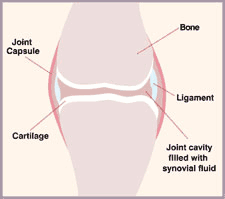A joint is formed when two bones are brought together and held in place by supporting tissues. Joints may have large ranges of movement such as the shoulder and hip joints, or have very little movement such as the joints between the bones in the skull.
There are three types of joints based upon the type of tissues that connect the bones.
Synovial joints
 Synovial joints generally have the greatest range of movement. In a synovial joint, the bone ends are covered with cartilage. Tough fibrous tissue encloses the area between the bone ends and is called the joint capsule. Ligaments, which are also made of tough fibrous tissue help hold the bones in alignment. The ligaments may be part of the joint capsule or inside of it or outside of it. The area inside the joint capsule is called the joint cavity and is filled with a fluid called synovial (joint) fluid. Examples of synovial joints include the joints in the legs and the temporomandibular joint which joins the skull to the lower jaw.
Synovial joints generally have the greatest range of movement. In a synovial joint, the bone ends are covered with cartilage. Tough fibrous tissue encloses the area between the bone ends and is called the joint capsule. Ligaments, which are also made of tough fibrous tissue help hold the bones in alignment. The ligaments may be part of the joint capsule or inside of it or outside of it. The area inside the joint capsule is called the joint cavity and is filled with a fluid called synovial (joint) fluid. Examples of synovial joints include the joints in the legs and the temporomandibular joint which joins the skull to the lower jaw.
Fibrous joints
Fibrous joints allow very little movement. The bones are held together tightly by tough, fibrous tissue. Fibrous joints include those that join the bones of the skull together. The skull is actually made up of over 40 different bones, all tightly held together by this fibrous tissue.
Cartilage joints
Cartilage joints allow some movement and are formed when two or more bones are joined by cartilage. The joints formed between each vertebra in the spine are cartilage joints. The intervertebral disc is actually cartilage, which joins two vertebrae together.
 Free Forum Hosting
Free Forum Hosting